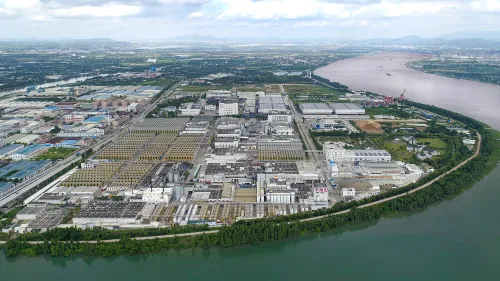
What hinders manufacturing firms from lowering their carbon footprint
Chevron Singapore Country Chairman Law Tat Win said the right policies and partnerships are needed for a cleaner energy shift.
Singapore has several firms that excel in climate reporting but Singapore Exchange noted that other companies have room for improvement. The chairman of manufacturing firm Chevron Singapore, Law Tat Win, said that there are still obstacles hounding manufacturing companies from adapting to low-carbon solutions.
He cited that the lack of one common methodology to trace carbon emissions is one of the challenges in a shift to lower carbon solutions.
Tat Win said, striking the right partnerships and investment decisions will boost alternative energy solutions amongst manufacturing firms. Another way is for governments to initiate clear policies that would boost lower carbon energy solutions.
In an interview with Singapore Business Review, Tat Win expounded strides in low carbon solutions such as carbon capture, utilisation and storage technologies (CCUS), and Chevron’s actions in growing its lower carbon business in renewable fuels and products, hydrogen, offsets and emerging lower carbon opportunities. Tat Win also discussed these alternative energy solutions during a closed-door meeting at the Industrial Transformation Asia Pacific 2022 last October.
How is Chevron pushing for alternative energy solutions?
Big scalable lower-carbon solutionsare complex. It's not that straightforward. It's not something that one company or country can achieve on its own.
To a larger extent, we need to work with stakeholders in the whole ecosystem and ensure that we have the right policies, technology advancements, and partnerships with like-minded partners including governments, industry partners, or universities.
As a company, we have been around for about 140 years, building up a fair bit of assets as well as capabilities and customer relationships over this time. We would hope to leverage our capabilities to help advance lower carbon solutions and deliver affordable, reliable, and ever-cleaner energy to our customers.
For us, to bring together the partnerships, it's necessary to have the right mindset that we are prepared to collaborate. An example of this is the Chevron Technology Ventures Fund. Chevron Technology Ventures has a 23-year history of investing in start-ups across a wide cross section of energy innovation and a track record of collaboration to bring innovation to scale.
Our future energy funds, the most recent of which launched in February 2021, have committed $400 million to invest in companies with low-carbon technologies. We are making investments and partnering with our start-up companies in new areas such as CCUS, hydrogen, ammonia production, and even in carbon management as well for offsets.
Even in new areas, we might not have any business lines in. But we feel that could make a difference as well, in the energy space for the future.
For example, we have invested in nuclear-related technologies. I think that interest is not just to help some of these companies advance their technologies, but it's also to understand how the landscape is shaping and how Chevron can play its role.
There are a few more elements that are important in this area of scaling up new energy solutions. One is carbon footprinting.
We need data and transparent processes to validate and verify that end-to-end for the whole value chain versus the current baseline that carbon intensity does get reduced.
But there's yet to be one common methodology today in terms of how carbon across the value chain is being tracked and traced.Hence, coming up with a standard that the industry can stand behind and for which other key stakeholders in particular governments also can stand behind is an important journey that we need to embark on.
In the Singapore context, we worked with Pavilion Energy to jointly develop a greenhouse gas (GHG) quantification and reporting methodology for liquified natural gas (LNG) cargoes. This LNG carbon foot printing methodology aims to deliver a cargo specific GHG emissions profile based on the carbon footprint of the supply chain from wellhead to delivery point.
The Statement of Greenhouse Gas Emissions (SGE) Methodology is one of the first published methodologies specifically developed to quantify the greenhouse gas (GHG) emissions associated with a delivered liquefied natural gas (LNG) cargo. It provides a measurement, reporting and verification methodology which compliments common GHG reporting processes to deliver a consistent, verified SGE for each delivered LNG cargo.
We had this methodology validated by academia and by other industry partners.
This is very unique to LNG. As we just started this new supply chain for the low carbon space, we need to have dedicated methodologies established for each of these new supply chains that are being put forth, so that we know how much CO2 is being abated through the efforts that we are embarking on.
Another key ingredient that is needed to help advance our efforts is industry platforms, where industry partners can come together to brainstorm and partner in the low-carbon space.
In the marine space, specifically in Singapore, we found the Global Centre for Marine Decarbonisation (GCMD) as a good partner for us to collaborate with. Through that platform, we are embarking on several pilots.
In the space of biofuels, how we can scale up the adoption of renewable fuels in marine space and the pilot we embarked on will cut across three continents across 13 ports. This brings together a group of partners as well to establish the technology of how we trace the biofuels as being utilised across the supply chain. At the same time, also looks at the carbon accounting elements associated with the biofuels that are to be adopted.
What are the main challenges of manufacturing facilities when shifting to green solutions?
No one solution would help a manufacturing facility shift to the lowest carbon footprint. It is primarily because for each of the jurisdictions that manufacturing facilities face a few different sets of parameters that we need to deal with.
The different governments have different policies that would enable lower carbon solutions, but some are more advanced than others. Some have a carbon price in place, whilst others have none.
The second thing is the availability of technology. For example, in the space of carbon capture and storage (CCS). If you're looking at a storage solution, such as in Singapore, you might be able to capture the carbon, but you might not be able to stop the CO2. You need to look at a different kind of solution for you to implement a CCS.
The third one is also in terms of the sustainability of the manufacturing facilities. For some, most of these lower carbon solutions will come at a cost, the ability to have a transparent marketplace, whereby the cost itself can be made transparent. At the same time, customers know what they're paying for is going to be very important in the overall equation.
The challenges that we face today, we are hoping to provide not just a reliable supply of energy, but affordable energy as well. Affordability needs to be featured quite prominently in the solutions that have been delivered. All these three and the complexity of energy security need to come together.
When you put all these elements together, it becomes quite complex to have one solution that can meet all the needs of manufacturing facilities across the different jurisdictions that the facilities might be in. It requires us to be patient and to work with the different stakeholders to understand each of the locations in which we are operating. We might want to prioritise the different efforts to lower carbon, so that we can be the most efficient in getting from where we are, to where we want to be.
It will require us to work with the right policies in place, and to work very closely with industry partners, to test out new technologies, and to build up new infrastructure.
And at the end of the day, we need to assemble the different parts of the overall supply chain, so that we can deliver affordable, reliable, and low-carbon solutions of energy to the manufacturing facilities that call for it.
For our businesses to be sustainable, the financial elements will be a very key important consideration as well. We can be responsible for making sure that whatever we do is not just for the short term, but because of the investments that we're making, particularly for manufacturing assets.
Many of the manufacturing companies are making investments over the next 10, 20, and 30 years. They hope that those assets will be able to be in place and hence have some clarity in terms of the policy.
Working very closely with the governments and making sure that whatever investments are being made in lower carbon space, will be still functional and applicable for the medium to longer term.
If the investments are just in the short term, and policy keeps shifting and changing, it is very difficult for the manufacturing facilities to think about where the goalpost is, and what kind of investments they are going to make for the longer term.
How can countries make clearer policies for manufacturing companies when shifting to greener solutions?
Each country would be managing this quite differently. It requires both the private sector and public sector to have frequent, open, and transparent dialogue in terms of how the specific operations within the jurisdiction that they are in are going to be.
Where policies are clear, it would be easier for companies to know how they need to be responsible for the capital of their shareholders and that they are investing in these specific locations.
Governments also need to recognise that there's a partnership between the public and private sector. That's probably required to help manoeuvre through some of the complexities and uncertainties that lie ahead.
When we interact with the Singapore government, they have been very eager to work with industry and have a general openness as well, to really not just headstart technologies, but also to create like a sandbox. This sandbox allows us to test out new policies in a very confined way.
That sandbox can allow both the private and public sector to collaborate and evolve. I look forward to more opportunities that might be in the space of lower carbon or CCUS, hydrogen oil and offsets.
How does Chevron select its partners in terms of achieving its sustainability goals?
To be able to deliver on and develop new energy solutions is what we look for in a partner. It doesn't need to be exactly an overlap but it's complementary capabilities that we can bring together. That's more on the tangible side.
I bring it down to more of the intangibles as well, which is equally important as what we might contribute on the other qualitative fronts of shared capabilities, assets, and insights. We cannot force a partnership to happen but it's probably through the test of time and working together building the relationship, we can make a partnership successful.
If you think about Chevron downstream in Asia, partnerships might be in Korea, Singapore, or Thailand, we have different joint venture partners in each of the locations that we operate.
We hope to apply that kind of mindset to the new energy space as well. This is a new space and having the right partners would enable us to be more successful in delivering lower carbon energy to our customers.



















